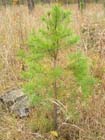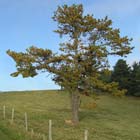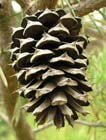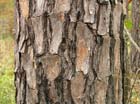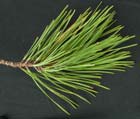Conservation Status

Pinus virginiana
Miller 1768
Common names
Virginia pine, scrub pine, spruce pine, Jersey pine (Carter and Snow 1990).
Taxonomic notes
Syn.: Pinus inops Aiton 1789; Pinus turbinata Bosc ex Loudon 1842 (Farjon 1998).
This species belongs to subgenus Pinus, section Contortae, which consists of four closely related North American two-needled pines. Experimental crosses have succeeded in hybridizing P. virginiana with only one of these four, Pinus clausa (Carter and Snow 1990). The four species of section Contortae have done an admirable job of dividing up the available terrain; Pinus clausa occupies poor soils on fire-prone sites in the hot southeastern U.S., P. virginiana does the same thing in the temperate regions of the eastern U.S.; P. banksiana carries the torch high into the boreal forest; and P. contorta with its three subspecies does the same thing across western North America from Baja to Yukon.
Description
Monoecious evergreen trees 9-18(-32) m tall and 30-50(-83) cm dbh. Straight to contorted with usually a single round trunk and an irregular crown of long, spreading, ascending to descending branches. Bark smooth, then reddish, scaly, finally gray-brown, thick, shaggy. Branchlets slender, reddish or purplish, often glaucous, aging red-brown to gray, rough. Foliar buds ovoid to cylindric, red-brown, 0.6-1cm, sometimes resinous; scale margins white, fringed. Needles 2 per fascicle, (2-)4-8 cm × 1-1.5 mm, twisted, deep to pale yellow-green, all surfaces with inconspicuous stomatal lines, margins serrulate, apex narrowly acute; sheath 0.4-1cm, persistent; needles live 3-4 years. Pollen cones ellipsoid-cylindric, 10-20 mm, red-brown or yellow. Seed cones borne throughout the tree's crown and persisting for up to 5 years; symmetrical, narrowly ovoid, when open, (3-)4-7(-8) cm long, red-brown, nearly sessile or on stalks to 1 cm, scales rigid, with strong purple-red or purple-brown border on adaxial surface distally; apophyses slightly thickened, slightly elongate; umbo central, low-pyramidal, with slender, stiff prickle. Seeds 4-7 mm, compressed-obovoid, mottled brown, with a narrow wing up to 20 mm long. 2n=24" (Little 1980, Carter and Snow 1990, Kral 1993, and my field observations). See García Esteban et al. (2004) for a detailed characterization of the wood anatomy.
Life History: Vegetative reproduction does not occur naturally. Pollination (by wind) occurs from mid-March to late May depending on local temperatures. Fertilization occurs 13 months later, when the cones are nearly at full size, and cones mature between late September and early November. Seed disperse shortly thereafter, although cones typically remain on the tree for several (up to 15) years. Some cones mature every year, with mast crops about every 3 years. Seedlings require an exposed mineral soil seedbed and direct sunlight, and are relatively drought-tolerant compared to most pine seedlings. In favorable conditions seedlings may be 10-20 cm tall after the first year and 5 m tall after 10 years, reaching maturity after about 60 years; cone production may begin as early as 5 years or as late as 50 depending on stocking and other factors. Mortality can have many causes; among the most commonly observed are fire, windthrow, effects due to competition during succession to a hardwood forest, heart rot due to Phellinus pini, pitch canker due to Fusarium moniliforme var. subglutinans, and insect attack by pine beetle (Dendroctonus frontalis), sawflies (Neodiprion spp.), and pales weevil (Hylobius pales, attacks seedlings). Virginia pine is also sensitive to air pollutants including ozone, sulfur dioxide and nitrogen oxides (Carter and Snow 1990).
Distribution and Ecology
USA: New York, New Jersey, Pennsylvania, Ohio, Indiana, Kentucky, Tennessee, Mississippi, Alabama, Georgia, South Carolina, North Carolina, West Virgina, Virginia, Maryland and Delaware at 0-900 m on dry uplands, sterile sandy or shaly barrens, old fields, and lower mountains (Kral 1993). Naturalized in Canada: Alberta, British Columbia, and Ontario (Brouillet et al. 2006, cited by PLANTS database 2009.03.31). See also Thompson et al. (1999). Hardy to Zone 6 (cold hardiness limit between -23.2°C and -17.8°C) (Bannister and Neuner 2001).
Distribution data from USGS (1999). Also take a look at this offsite range map (Prasad and Iverson 1999).
Precipitation within the range of this species averages 890-1400 mm, with the wettest areas in the southern portion of its range, and is fairly evenly distributed throughout the year. Summer average temperatures are 21° to 24°C and winter temperatures average -4° to 4°C. It grows best on well-drained clay, loam, or sandy loam soils with silicate parent rocks, but also grows in areas of limestone and shale; on less well-drained sites it gives way to other species such as P. taeda (Carter and Snow 1990).
This species is commonly early seral, appearing in old fields or other disturbed sites and regenerating rapidly after fire. It forms a dominant cover type with various understory oaks (Quercus sp.), and is an associated species in a variety of oak forest types as well as in some forest types dominated by Pinus rigida, P. echinata, P. taeda, P. pungens, P. palustris, P. strobus, Tsuga canadensis, or Juniperus virginiana (Carter and Snow 1990). These associations vary considerably with geography; it is associated with P. rigida and P. pungens in the Appalachian Mountains, with Pinus
taeda on the eastern shores of Virginia and Maryland, and with P. echinata in the Piedmont region (Sullivan 1993 and sources therein).
The following remarks on fire ecology of Virginia pine are quoted from Sullivan (1993):
Virginia pine is not well adapted to survive fire due to thin bark and shallow roots. Large trees however, are apparently able to survive fires. Virginia pine stands that include six size classes (d.b.h) have been documented. This size distribution is apparently due to fires that burned at approximately 20- to 30-year intervals. The larger trees, therefore, survived at least one fire. Virginia pine populations are maintained by fire or other disturbance; Virginia pine is a colonizer of recently burned sites. Root crown sprouts have been reported, but are apparently not an important fire survival mechanism.
Fire regimes in habitats containing Virginia pine have been altered by humans for many years. It is thought that prior to European settlement, Indians maintained large tracts of pine forests through intentional burning of forest lands for various purposes (e.g., agriculture, wildlife harvest). These fires created a patchwork of communities, increasing the amount of area covered by pioneer or pyrophytic species such as Virginia and pitch pines. Currently, lightning fires do occur, but are of low importance compared to those started by people. Landers estimated the fire return interval in the southeastern United States at approximately 2 fires of high intensity per 100 years. In the Great Smoky Mountains National Park, Tennesee and South Carolina, fire intervals for 1856 to 1900 and for 1900 to 1940 were both estimated to be 9.2 years below 2,000 feet (610 m) elevation, and 11.3 years above that elevation.
Remarkable Specimens
The largest is diameter 83 cm, height 31 m, crown spread 15 m, located in Madisonville, Kentucky (American Forests 1996). The tallest known one is 37.28 m tall and grows in extreme NE Georgia in the watershed of Morsingills Creek, only a few feet from the tallest known P. rigida (Riddle 2011). Another very tall tree in Great Smoky Mountains National Park is 33.83 m tall (Rucker 2003).
The oldest known living specimen, 176 years, was documented in a tree-ring chronology covering the period 1830-2005 (crossdated after 1866), collected from the New River Gorge in West Virginia by R. S. Maxwell and R. R. Hicks Jr. (doi.org/10.25921/vg6x-s667). Only one chronology is recorded for this species, so substantially older trees may exist. However, the species is said to become senescent at ages of 65 to 90 years, and to rarely live more than 150 years (Sullivan 1993). This assertion is supported by the tree-ring chronology, which contains 16 trees having an average age of only 88 years.
Ethnobotany
The Cherokee used this species medicinally, for a startling array of ailments including (Hamel and Chiltoskey 1975):
- diarrhea (bark chewed)
- rheumatism (to bathe joints, and taken internally)
- cold remedy (infusion, steam and oil used in various ways)
- swollen breasts (poultice)
- fever (infusion of needles)
- hemorrhoids (infusion of roots)
- swollen testicles caused by mumps (syrup used as poultice)
- tuberculosis (tar used, not specified how)
- constipation, intestinal worms, colics, measles, hysterics, venereal disease (method not specified)
and also for the following purposes:
- Branches burned and ashes thrown on hearth fire after a death in the home
- Compound infusion of needles in apple juice taken by ball players "for wind."
- Compound infusion of root taken as a stimulant.
- Needles or gum used to scent soap.
Economically, Virginia pine was historically used for mine timbers, railroad ties,
rough lumber, fuel, tar, and charcoal. Currently it is primarily grown for pulpuse as a pulp, especially through the reforestation of abandoned agricultural lands, cutover, and mined sites. It is widely planted in the middle and southern Appalachian region during revegetation of surface coal mine spoils (FEIS database).
Observations
The species can be easily found throughout most of its range, and indeed is the predominant pine on dry sites at low to moderate elevations. Among other places, it occurs in Shenandoah National Park, Mammoth Cave National Park and Great Smoky Mountains National Park.
Remarks
The epithet refers to the species' occurrence in "Virginia", which in the mid-18th century broadly referred to the central region of Britain's North American colonies.
Virginia pine seeds are an important food source for many small mammals
and birds. Older trees that have begun to suffer stem rot provide good nesting sites for woodpeckers. When used for revegetation of mine spoils, Virginia pine has high value for wildlife cover and food, and is locally very important for foraging white-tailed deer (FEIS database).
Citations
American Forests 1996. The 1996-1997 National Register of Big Trees. Washington, DC: American Forests.
Brouillet, L., F. Coursol, and M. Favreau. 2006. VASCAN. The database of Canadian vascular plants. Herbier Marie-Victorin, Institut de recherche en biologie végétale, Université de Montréal.
Carter, K.K. and A.G. Snow Jr. 1990. Pinus virginiana Mill., Virginia Pine. Pp. 513-519 in Burns and Honkala.
Hamel, Paul B. and Mary U. Chiltoskey. 1975. Cherokee Plants and Their Uses -- A 400 Year History. Sylva, N.C.: Herald Publishing Co.
Miller, Ph. 1768. The Gardener's Dictionary, ed. 8 (no pagination).
Riddle, Jess. 2011. Warwoman Road Update. http://www.ents-bbs.org/viewtopic.php?f=73&t=1879&hilit=pine+shortleaf, accessed 2012.09.18.
Sullivan, Janet. 1993. Pinus virginiana. In: Fire Effects Information
System. Available:
https://www.fs.usda.gov/database/feis/plants/tree/pinvir/all.html, accessed 2023.11.06.
See also
Elwes and Henry 1906-1913 at the Biodiversity Heritage Library. This series of volumes, privately printed, provides some of the most engaging descriptions of conifers ever published. Although they only treat species cultivated in the U.K. and Ireland, and the taxonomy is a bit dated, still these accounts are thorough, treating such topics as species description, range, varieties, exceptionally old or tall specimens, remarkable trees, and cultivation. Despite being over a century old, they are generally accurate, and are illustrated with some remarkable photographs and lithographs.
Pinus virginiana Mill., Virginia pine - Biodiversity of Great Smoky Mountains National Park, accessed 2009.03.28. Recommended!
Sargent (1897) provides an exceptionally detailed description of this species, with an excellent illustration.

